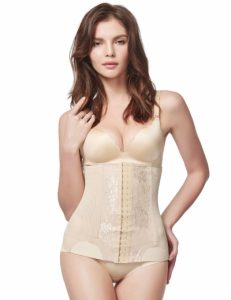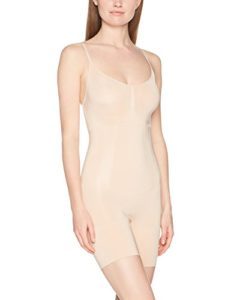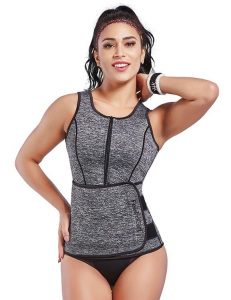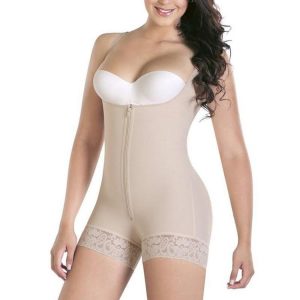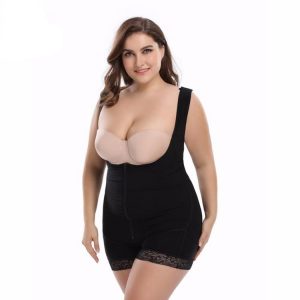A couple of years back, I determined that I would not wear shapewear again. Not really because I believe it’s “wrong” to do so by itself (if that choice is from a place of personal preference). Neither was this because searching through a brief history of shapewear revealed precisely how messed up beauty standards have already been since the daybreak of world. My decision stemmed mainly from the epiphany that I failed to need shapewear at all. They have main purpose in my very own life was to offer protection against some severe thigh chafing. And so why should I have to draw in my tummy, ass, and lower upper thighs to achieve that?
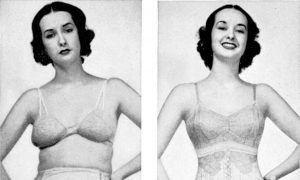
I actually often feel lucky, mainly because despite an undesirable body image right here or generally there (one that always consists of chastising myself because of not having the evasive glowing encounter magazines show me is “in” or shouting at my curls for not resembling Julia Roberts’ in Quite Woman or being disappointed that my bottom, even though very wide, just isn’t extremely plump), Now i am usually quite comfortable and confident inside my fat body.
confident in one, feeling comfortable and Unfortunately’s body isn’t the status quo. They have not the concept being preached when you open up a publication whilst waiting in-line at the food store to purchase some Cheez-Its. It’s not really the message we obtain when advertisements are informing us that nipping, drawing, and concealing are a female’s principal sartorial goals with this existence. And it’s really certainly not a note that bands through when you look into the evolution of shapewear tendencies over time. Which I mean.
1 .Ancient Crete: Boobs Away & Waistline In
The first recorded edition of shapewear dates back to Mycenaean Portugal, likely at some time between 1, 600 to at least one, 100 BC. According to lingerie useful resource and shop Dollhouse Bettie, the historic Minoans exactly who lived upon Crete a long time before the Athenian invasion weren’t as focused on decency and nudity because their conquerers. “While the Cretans had recognized the female type in all the glorious sensuality, and produced undergarments to emphasise the breasts, hips, and waist, underwear in Historic Greece was another matter entirely, inch wrote Doll house Bettie. “The Cretan crinoline and corset would have experienced no place in Athenian culture, and putting on such products would have been beyond obscene and in no chance tolerated. inch
Artwork of times tends to claim that the Minoan (or historic Cretan) ladies would wear their particular breasts completely out, hard nips free and pushed up by corsetry that concurrently brought in the waist. A few Ancient Greek bras, like mastoeides, actually helped push breasts out of clothing. Yet what’s also interesting to notice is that in several functions, women are depicted because having the previously mentioned hourglass number, but with rather arms, broad shoulders and strong. The dainty figure we’re going see produced by shapewear later on did not necessarily apply here. Rather, emphasis has been put on striking an equilibrium between the figure of femininity and the physical strength of masculinity.
2. Hellenic Portugal: Metal Adornments
According to the Encyclopedia Of Style, “The communities of the Ancient greek island of Crete [… ] and the ones of Hellenic Greece (the period prior to Alexander The fantastic (356 to 323 BCE) [… ] also discovered the art of metalwork, and they produced decorative metallic girdles an essential part of their particular fashionable gown. ” Oh yea, girdles. The Role Of girls In The ability of Ancient Portugal also clarifies that “there are several references to girdles in the Iliad and the Odyssey. ”
Girdles were also made of sheets and leather that is soft during this time, most of the time facilitating the hourglass form that experienced already began to be a thing equatable to desirability. Early manifestations of the girdle seem to have experienced an element of mysteriousness to all of them as an additional coating of clothes separating simple mortals from beautiful ladies.
Take this passing from the Iliad: “She spake, and loosed from her bosom the broidered girdle [… ] curiously-wrought, in which are designed all manner of allurements; therein is definitely love, therein desire, therein dalliance Cbeguilement that steals the wits actually of the smart. This early shapewear was a sign of libido, no doubt, yet one that arrived the form of the garment that ultimately helped change the form of your organic body.
3. Ancient Ancient rome: Breast Binders
Besides adding to modern incarnations of technology, warfare, and politics, the Ancient Romans also offered us something else: breasts binders. In contrast to the Minoans who chosen free hard nips and perked boobies, the wonder standard for ladies at the time was “slender, with small breasts and huge hips, inch according to Forbes. “A breastband (strophium) similar to a bandeau best was utilized to bind breasts, and in accordance to historic records, trustworthy women held the breastbands on during intercourse, to the lament of their particular husbands. inch
Oftentimes whenever we consider shapewear, images of tummies hidden and improved waists spring to mind yet very hardly ever do I individually conjure up images of shrinking the ta-tas. I am unable to help yet wonder if this marked a shift generally perception of female nudity. Were breasts starting to become indecent? Guilty? Shameful? Just for the bedroom, and perhaps not even after that?
These days, upper body binders could be extreme options for empowerment just for LGBTQ people, of course , especially for transgender men, nonbinary AMAB people, or anyone that simply is not going to feel because at-home within a body which has boobs. However origins appear, well, just a little rooted in sexism. Like, the kind of sexism we’re still fighting centuries down the line since humans still freak the eff away when they visit a mother breastfeeding a baby in public.
4. The Middle Age groups: Bodices & Paste
Throughout the Middle Ages that big chunk of your time between the fifth and fifteenth centuries women had been gifted with “tightly laced bodices stiffened with insert to control and smooth their particular figures, inch as Standing reported. Except for the Romans, the hourglass figure has been one of the most coveted since basically permanently. But really curious that there are little to suggest weight loss was also a primary goal. The majority of research (again, with the exception of that surrounding Rome) implies that “ideal” female physiques were regarding the shape much more than the scale. So in ways, the term shapewear was the the majority of accurate the ever been in the day.
Even though the metal girdles of Hellenic Greece no longer sound like the comfiest issues to wear, the center Ages appear to mark a focus on more painful routines the entire suffering with regard to beauty factor. Just picture Elizabeth from Pirates From the Caribbean fainting into the ocean because her corset did not allow her to inhale. That’s the actual Middle Ages arranged us on with.
5. Elizabethan Era: Metal & Petticoats
And then this became regarding the sides. Come the later 1500s, concerns drifted downwards, huge petticoats heading underneath dresses to create the illusion of width, whilst steel corsetry was designed to flatten and conceal the chest. In accordance to “History Of The Elizabethan Corset, inch “In the 16th hundred years, the corset was not designed to draw in the waist and create an hourglass number; rather, it had been designed to form the upper body into a cylindrical shape, and also to flatten and raise the bust-line [… ] On the whole, it had been a fashionably flat-torsoed form, rather than a small waist, the fact that corset was created to achieve. inch
Petticoats may not be a first choice symbol of shapewear because far the modern interpretations go, yet ultimately, gowns kind of what they had been (and remain): Items made to mold the form into what ever is “fashionable” at the time. Since breasts became parts of the body looking for being hidden, perhaps there is a desire to have women to demonstrate off their particular femininity consist of, less sexually-connoted ways. Your petticoat, which implies width on the hips. To put it differently, an optimum childbearing body.
6. Victorian Era: Whale Bones & Other Extreme conditions
What is it with all the Victorian Period and its darned extremes in the past due 19th hundred years? It was about sexual restraining and “morality” and yet i was putting females in no matter what would get them to look one of the most voluptuous. “Women squeezed themselves into corsets that shaped their statistics to fit the Victorian ideal: A sexy bosom on top of a teensy waist, inch reported NPR. As HerRoom. com observed in its iconographic of shapewear through period, Victorian shapewear was about “the corset, made from large canvas with whale bone fragments or metal, [which] made an extreme hourglass shape. inch It was therefore tight, actually that “Victorian women frequently needed help [… ] They would lie down on the floor whilst someone place a feet on their as well as pull the corset remains as hard as they can to tighten up them. inch
In keeping with background, it would seem the hourglass was, indeed, still amongst the many desirable body types females of the globe could provide. So why not pull your body in to the tightest whale bone corset out generally there to give the impression of a waistline the size of a toddler’s? Appears totally good, right?
Details took a turn, even though. “Since corset frames had been mostly made from metal, that was needed for ammo and various other military items (during Globe War I), the U. S. Battle Industries Plank asked American women in 1917 to stop buying them. Throughout the same period, the modern-day bra clearing up wartime steel, women alike and emerged. inch
7. The 1920s: Everything Svelte
OKAY, so then your First Globe War emerged, and the army needed the steel. Your flapper visual. All all of us fashion enthusiasts know that the era was characterized by slight silhouettes, “boyish” frames, and a more shapeless sartorial shape altogether. HerRoom. com reported that “shape was away and slim was in. Camisoles, panties, teddies, and bras were utilized to bind breasts and conceal curves. inch Perhaps it was the beginning of a focus on slimness as well as form.
So arrive mass and global worldwide conflict, “Whale bone was replaced simply by cheaper level spiral-steels at the start of the twentieth century, as well as the corset offered way to lighter girdles in the 1920s and 1930s, inch according to NPR. This wasn’t a lot that battle signaled a finish of corsetry and shapewear. Rather, factors had to become lighter, less expensive, and simpler. In this case, the shapewear regular and beauty regular, at that may have more certainly been right down to social and financial weather than everything else.
8. Ww ii: All About The Girdle
Book definitions often dub girdles something of the “lightweight undergarment, worn specifically by ladies, often partially or completely of flexible or boned, for assisting and providing a thinner appearance towards the abdomen, sides, and buttocks. ” You are able to often discover them attached with thigh-high pantyhose, and they had been all the rage during World War II. The lightweight character of the shapewear combined with the truth that it can be made a vast amount of less fabric than a petticoat or high quality corset managed to get pretty perfect for times of financial scrimping.
This is also when we start to see shapewear as we know this today. Elasticated, tight-to-the-figure styles that provide the purpose of producing the body appearance as slim as possible. Evidently, “Secret wallets were stitched into girdles during WORLD WAR II to safekeep important files and products, ” in accordance to HerRoom. So this is a little reward, I guess.
9. The 1955s: Hourglass Has returned
In what of HerRoom, the ’50s marked the start of the “boom and knocker years. inch “Shapely numbers were made up of bullet, cantilevered, and cushioned bras. Contemporary materials like nylon and polyester had been used with whale bone in waist-cinching girdles. ”
It was the period of pinup girls. No more were boobs hidden at the rear of constrictive materials and crazy steel, yet pushed plan the help of bras and the kind of shapewear we know and love/hate today. Like the last several years, a certain kind of slimness remained “in. ” Yet this time around, even tummies had been accented simply by hourglass statistics and sexy ta-tas. And maybe this is when we all began to claim back our breasts after too much time spent hiding all of them at all costs mainly because #shame.
10. The 1990s: Shapewear Just for Slimming
While not much is certainly written about shapewear trends in the ’90s, we know the decade was your era from the Kate Moss-esque “heroin chic” aesthetic. And browsing through classic shapewear in the ’90s at the Internet suggests this is when we all started to find elasticated materials get a lot more intense. Slimness remained in, only on this occasion, extreme slimness. So it is practical that our shapewear would develop to match that.
I remember viewing my mom in amazement as the lady got looking forward to dinners and parties in the later on ’90s. There was clearly never a dress that may be worn those babies. With promises of creating you appearance two sizes smaller sans any kind of diet plan or fitness change, whom could possibly withstand the extremely shaping shapewear of the instances?
11. Today: Is Shapewear Taking A Switch?
In 2015, conversations encircling body image got something of the turn. “Body positivity” became a parole of types the idea that every body, just as it really is, is worthwhile, beautiful, and good infiltrating more homes than probably ever before. Slim privilege continues to be very genuine, as is the association among thinness and aspirational beauty. But we have also began to see in addition size and mature versions featured in Sports Illustrated. We’ve began to see versions above a size twenty two land main agency offers. We’ve began to see body fat, unapologetic babes win internationally beloved actuality television shows. Therefore maybe, simply maybe, the shapewear is definitely starting to be more about functionality than alleged perfection.
Get into a company like Bandelttes, that provides anti-chafing groups that cover only the legs in the same Spanx-like fabric we may see much more formal shapewear. These products are providing a solution to a issue (chub stroke! ) whilst not suggesting the fact that body must be changed or molded along the way. Of course , we now have a long way to visit before size inclusion and fat approval are recognized concepts. However in the interim, it’s fairly exciting to find out that there are types of shapewear evolving which have nothing related to slimming, plumping, tucking, or shaping.
The evolution of shapewear is usually a long and whale bone-infested one, when there’s anything at all it shows, it’s this: Beauty requirements change. They will change fast. They modify so fast that it’s extremely difficult to know what a “good body” or “bad body” is at a moment. But on the other hand that’s as there is no this kind of thing because the latter.
Intended for as long as cultures have roamed this crazy planet, it can as though there has been a beauty standard. Requirements rooted economic, social, gender-based, and ethical climates. A lot of us have acquiesced to those beauty standards, maybe out of fear of becoming different or maybe the simple presumption that these requirements are grounded in any kind of truth or truth (likely mainly because they’re so frequently presented since such). Yet perhaps we will keep viewing shapewear develop as more and more people recognize that there is such issue as a general body type. Which the specifications we convey should be just those of the choosing, whether they’re “in” or “dated” or our personal concoction of beauty.



